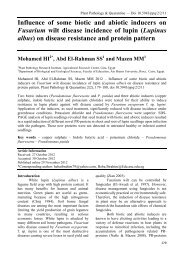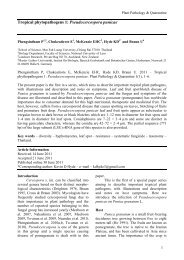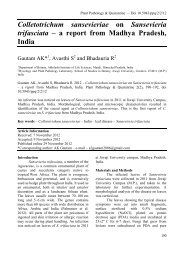Genus Cercospora in Thailand: Taxonomy and Phylogeny (with a ...
Genus Cercospora in Thailand: Taxonomy and Phylogeny (with a ...
Genus Cercospora in Thailand: Taxonomy and Phylogeny (with a ...
You also want an ePaper? Increase the reach of your titles
YUMPU automatically turns print PDFs into web optimized ePapers that Google loves.
Plant Pathology & Quarant<strong>in</strong>e<br />
Fig. 4 – Various types of conidia of the true cercosporoid fungi sensu Crous & Braun (2003) found<br />
<strong>in</strong> this study (40×) (black arrows: conidia hila, white arrows: septation). a. Conidia of genus<br />
<strong>Cercospora</strong> s. str. b. Conidium of genus Passalora. c. Conidia of genus Pseudocercospora.<br />
(Meeboon 2009).<br />
locus or unilocal) or polyblastic (<strong>with</strong> two or<br />
more conidiogenous loci or multilocal), formed<br />
either synchronously or, mostly; <strong>in</strong> a sympodial<br />
succession (Hennebert & Sutton 1994). Conidiophores<br />
(or conidiogenous cells) can be<br />
determ<strong>in</strong>ate (growth ceas<strong>in</strong>g <strong>with</strong> the production<br />
of a term<strong>in</strong>al conidium or conidial cha<strong>in</strong>)<br />
or they can proliferate [<strong>in</strong>determ<strong>in</strong>ate, proliferation<br />
be<strong>in</strong>g sympodial or percurrent (through<br />
the open end left when the first conidium<br />
becomes detached)] (Hennebert & Sutton<br />
1994). <strong>Cercospora</strong> is characterized by hav<strong>in</strong>g<br />
blastic (monopolyblastic), schizolytic, <strong>and</strong><br />
sympodial proliferation (Crous & Braun 2003).<br />
C. Conidia<br />
The important characters of conidia of<br />
the genus <strong>Cercospora</strong> are mostly related to the<br />
shape, septation, pigmentation <strong>and</strong> surface<br />
(Figs 4a–c), similar to the Saccardoan system<br />
(Crous & Braun 2003). The conidia of <strong>Cercospora</strong><br />
species are either straight to curved, <strong>and</strong><br />
acicular, filiform, obclavate or a comb<strong>in</strong>ation<br />
of shapes (Crous & Braun 2003). There are two<br />
basic types of septation, viz, euseptate (septa<br />
formed by all exist<strong>in</strong>g wall layers) <strong>and</strong><br />
distoseptate/pseudoseptate (septa formed only<br />
by the <strong>in</strong>nermost layer) (Hennebert & Sutton<br />
1994). The term septum (septate) <strong>with</strong>out<br />
specification is usually applied to euseptate<br />
(Hennebert & Sutton 1994).<br />
Hyal<strong>in</strong>e <strong>and</strong> pigmented conidial structures<br />
are usually well separated <strong>in</strong> certa<strong>in</strong> taxa<br />
(genera, species) of the cercosporoid fungi, but<br />
transitional phenomena are not uncommon<br />
(Crous & Braun 2003). However, taxa <strong>with</strong><br />
subhyal<strong>in</strong>e to pale (yellowish green, pale olivaceous,<br />
etc.) structures often cause serious<br />
taxonomic problems (Crous & Braun 2003).<br />
The conidia of <strong>Cercospora</strong> are characterized by<br />
hyal<strong>in</strong>e or pale olivaceous pigmentation <strong>and</strong><br />
euseptate conidial septation (Crous & Braun<br />
2003)<br />
Collection <strong>and</strong> Observation<br />
Specimen collection <strong>in</strong>volved an observation<br />
of the presence/absence of the fruit<strong>in</strong>g<br />
bodies/caespituli on the leaf. The observation<br />
was usually conducted us<strong>in</strong>g a 10× or 20×<br />
magnify<strong>in</strong>g lens. Specimens that are positively<br />
showed the presence of <strong>Cercospora</strong> fruit<strong>in</strong>g<br />
bodies/caespituli were placed <strong>in</strong> plastic bags.<br />
The collect<strong>in</strong>g bags were sealed <strong>and</strong> labeled:<br />
Name of host plants, Collection site, Collector<br />
/s, <strong>and</strong> Collection date.<br />
Detailed observations of morphological<br />
characters were generally carried out by means<br />
of a dissect<strong>in</strong>g microscope, followed by light<br />
compound microscope us<strong>in</strong>g oil immersion<br />
(1000×). Specimens for microscopic observation<br />
were prepared by h<strong>and</strong> section<strong>in</strong>g or f<strong>in</strong>e<br />
forceps. Water is very good as mount<strong>in</strong>g medium.<br />
Shear’s solution or lactophenol was<br />
usually used as a media for permanent slides.<br />
Thirty conidia, hila, conidiophores, conidiogenous<br />
loci <strong>and</strong> 10 stromata were commonly<br />
measured for each specimen. L<strong>in</strong>e draw<strong>in</strong>gs<br />
were prepared at a magnification of 400×, or<br />
17









